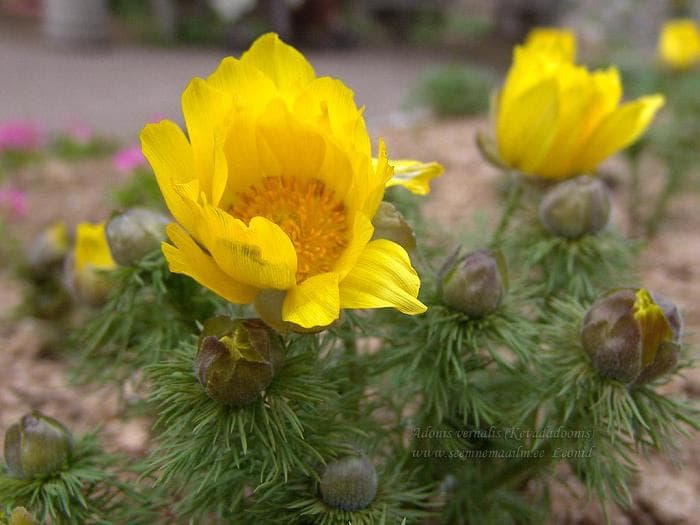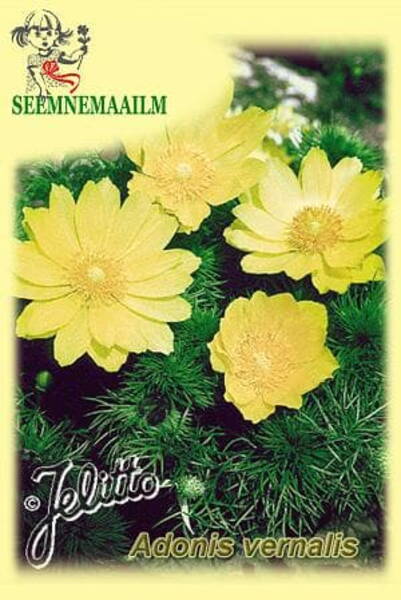A wonderful gift from Spring!
Perennial for the rockgarden. Medicinal plant.
Family: Ranunculaceae.
Origin: Europe, Altai Mountains, Siberia Special.
Features: large yellow flowers to 8 cm in diameter with fine foliage.
Colour of flowers: yellow.
Natural flowering period: IV-V.
Winter hardiness zones: Z2-8.
Potting of Adonis vernalis.
Pheasants Eyes need sandy soil that has had leaf mold or compost added. The soil should be moist, but well-drained. It is beneficial to Adonis vernalis if the soil was alkaline. These plants can be planted in a sunny or partially shaded spot. Adonis brevistyla needs a position sheltered from cold, dry winds.
Propagation of Adonis vernalis.
They may be divided when they ve finished flowering or fresh seeds may be sown in sandy soil in late summer, though they are ordinarily slow to germinate.

Yellow pheasant's eye, Spring pheasant's eye.
During flowering, the height of the plant is 15-30 cm. The leaves are openwork, palmately divided, with narrow lobes. The flowers are a gorgeous sunny yellow and brilliant. Used for rockeries and borders.
Flowers open in sunny weather. They close at night and on cloudy days. The seeds ripen in late June-early July. The leaves remain green throughout the summer.
Adonis spring is a very durable plant and reaches its maximum development by 40-50 years. The life expectancy is supposed to be at least 150 years, while its rhizomes almost do not grow, all plants are renewed by seeds. In cultivation, several varieties have been obtained from spring Adonis, including those with white flowers.
It has been known in folk medicine as a medicinal plant since the 16th century.
Adonis herb contains cardiac glycosides - natural compounds without which heart disease cannot be cured. (For information, Adonis herb is not used for home treatment in the form of teas and tinctures, since all types of Adonis are poisonous due to the glycosides it contains. Ready-made preparations are sold in pharmacies and taken as prescribed by a doctor.)
The first mention of growing Adonis spring in European gardens dates back to 1568. But its cultivation is still complex, and it is almost never found among amateur gardeners. This does not mean that it is impossible to grow adonis in your own garden; it is represented in the collections of many botanical gardens. With careful care and knowledge of biology, it can be successfully cultivated in your garden.
In the garden for spring Adonis, you should choose a place with fairly fertile, light-textured soil containing a small amount of lime. It is important to ensure reliable drainage and moderate soil moisture. Adonis is light-loving and in low light conditions it develops poorly and even dies.
The main difficulty of the culture is that the plant does not take root well when propagated by dividing the rhizome, and the seeds have low germination and poor germination due to underdevelopment of the embryo.
Seeds should be sown freshly collected in June-July, or even better unripe, when they are still green, in as large a quantity as possible, since their germination does not exceed 30%. It persists for one year and is completely lost in the second year.
When sowing, seeds are planted no deeper than 1-1.5 cm so that daylight penetrates them, promoting germination. Shoots appear after 30-40 days, sometimes later, in some cases even the next year in the spring. If there is no rain, it is necessary to water the ridges with crops almost daily, but moderately (under natural conditions, with heavy rains, the death of seedlings from fungal diseases has been observed). Watering is necessary during the first two years of the seedlings' life. In the first year, plants develop 1-2 leaves, in the second - up to 3 leaves.
Adonis can be planted in a permanent place after 2-3 years, placing the plants no closer than 50-60 cm from each other. In the future, replanting is not advisable due to the poor survival rate of adult specimens, and if necessary, plant them entirely (dividing the rhizome is not recommended) . Adonis is replanted with a large lump of earth.
An old gardening book gives this useful advice: put a significant layer of clay shards at the bottom of the planting hole, then leaf soil, and then plant the plant.












